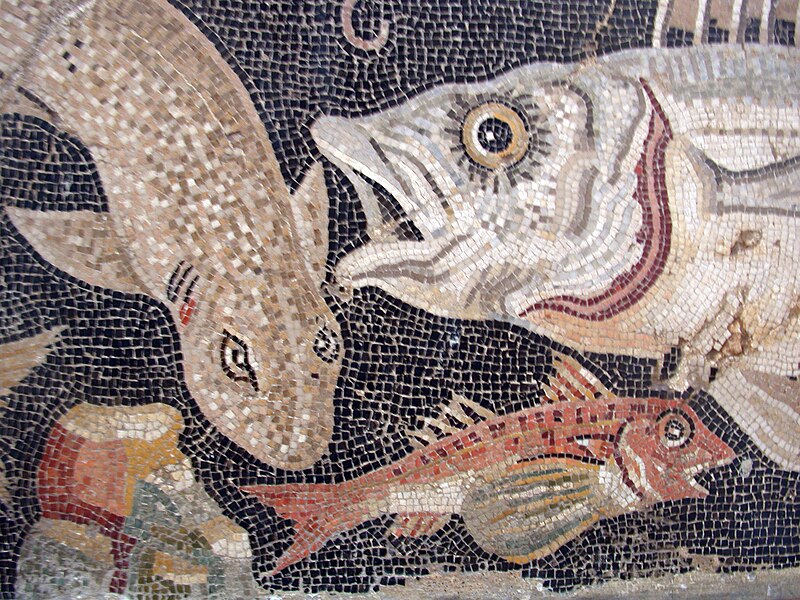
A mosaic of sea creatures found in Pompeii, circa 100 BCE. From the National Archaeological Museum of Naples, Italy. / Photo by Massimo Finizio.
By Tatiana Pollard
As you know, Kitchen Detail columnist Nancy Pollard ran one of the best cookware stores in America for almost 50 years. Well, the rock doesn’t fall all that far from the cliff: Daughter (one of two) Tatiana has a passion for, one, food and two, Italy, where she lives.
Juggling nuance between Italian and English, Tatiana lights up her five-burner kitchen top with nostalgia for American food, Bologna-inspired fare and cross-cultural inventions. She and her husband endlessly debate about cooking with or without a recipe. Their son just hopes that dinner will either be plain or have chocolate in it.
 THIS REALLY is about seafood inspiration, but let me set the scene for you first. Beach vacation options abound in Italy, with regions such as Puglia, Sardinia, and Sicily vying for the gold medal of bluest waters and palest sand. On the other end of the summer-holiday spectrum, the beaches of the upper Adriatic in Emilia Romagna are known for their efficient organization and tourist-friendly hospitality, despite having less-picturesque locations and murkier H2O. Le Marche and Abruzzo fall somewhere in between, with a focus on families and locals. A few years ago we vacayed in San Benedetto del Tronto in a self-catering apartment, which was perfect for our eight-person crew of grandparents, parents, and kids. Next year I struck out on my own with my son, then 7. Tempted by the gorgeous islands in the Mediterranean, but with limited options available, a last-minute deal from La Perla Preziosa in Grottammare for a week with full board was an offer I couldn’t refuse.
THIS REALLY is about seafood inspiration, but let me set the scene for you first. Beach vacation options abound in Italy, with regions such as Puglia, Sardinia, and Sicily vying for the gold medal of bluest waters and palest sand. On the other end of the summer-holiday spectrum, the beaches of the upper Adriatic in Emilia Romagna are known for their efficient organization and tourist-friendly hospitality, despite having less-picturesque locations and murkier H2O. Le Marche and Abruzzo fall somewhere in between, with a focus on families and locals. A few years ago we vacayed in San Benedetto del Tronto in a self-catering apartment, which was perfect for our eight-person crew of grandparents, parents, and kids. Next year I struck out on my own with my son, then 7. Tempted by the gorgeous islands in the Mediterranean, but with limited options available, a last-minute deal from La Perla Preziosa in Grottammare for a week with full board was an offer I couldn’t refuse.
Grottammare is a charming small town on the Adriatic coast in Le Marche with a lower area stretching into the sea and an upper area perched on a hill. Its historic medieval core overlooks the more modern beachtown landscape. Many hotels in the area offer the hospitality formula of room, serviced beach area with umbrella and chairs, and all meals included, which makes it really easy for parents, whether dual or single, to vacation with young children. Literally all we did was wake up, put on our swimsuits and roll out from the breakfast room to the beach without having to organize anything more than the bag with towels and sunblock. All gear and toys were already stored safely under my reserved chaise longue. Likewise meals were just as simple to arrange. Each evening we found a piece of paper listing the next day’s lunch and dinner menus with two choices for each meal (plus an extra children’s menu for less adventurous tykes). Dishes focus on seaside and local specialties, with a few excursions to other regions.
But one thing was sure to be on the menu: brodetto.
Brodetto (Adriatic fish soup)–Seafood Inspiration

Adriatic fish soup.
Any community with access to fish will eventually concoct a stew. Bouillabaisse, clam chowder, cullen skink, pindang, to name a few. Being a peninsula, Italy has a staggering quantity. Brodetto (Adriatic fish soup) is an Adriatic invention. Any food blogger, magazine, or wikipedia article will tell you that every port city along the Adriatic coast between Trieste and Vasto has its own brodetto variation. Cities like Chioggia, Fano, Ancona and San Benedetto del Tronto make claims of having the oldest or original recipe. We may never really know where it first appeared, but the process is so simple you can understand why it has so many variants, with nuance being created by something as uncomplicated as a vegetable or a single spice. Here are three variations for inspiration.
One of the creation stories behind brodetto is that it was originally made by fishermen with catch that couldn’t be sold at the market, either small or not highly valued. Likewise, the ingedients were few and could keep or were readily available while out at sea. Think cooking with sea water instead of fish stock, or wine that has turned to vinegar with exposure to the sun. Of course, brodetto is made with seafood from the Adriatic, but the recipe can be adapted to local offerings.
How Do You Brodetto?
In Fano they do brodetto like this. This Adriatic fish soup recipe uses 11 types of fish including cuttlefish, scampi, spiny dogfish, Mantis shrimp, European hake, red mullet, squid, angler or monkfish, tub gurnard, and sole. After having gutted and cleaned the fish (don’t forget to use those scraps for fish stock), cut up the larger ones into chunks. Heat up olive oil with a clove of garlic and diced onion. Once softened, add 60 ml of white wine vinegar. When evaporated, swirl in 80 grams of tomato paste. Put in the seafood that takes the longest to cook first (cuttlefish and calmari) and sauté 10 minutes. Pour in some hot water or fish stock and cover until it starts to simmer. Next to go in are gub turnard, spiny dogfish, monkfish, and hake. Finally the red mullets, sole, and crustaceans. Cook 10 minutes, but do not stir. Serve immediately with toasted bread.
In Porto Recanati you might eat some brodetto like this recipe from the restaurant Il diavolo del brodetto and published by the Italian online magazine dissapore. In some areas of Le Marche, saffron is traditionally used in brodetto. Other unique qualities of this version are the absence of tomatoes and the use of lightly floured fish, creating a more delicate flavor. Arm yourself with 1.5 kilos of seafood (including cuttlefish, common smooth hound, red mullet, sole, monkfish, cod, and red scorpionfish), a glass of white wine, a liter of fish stock made from the heads and carcasses of the fish used, an onion, olive oil, and saffron. Remove the heads and bones where possible. Cut the cuttlefish in small pieces and monkfish and houndshark into bigger chunks. Sauté the onions in olive oil until soft and then add the cuttlefish. Add hot water or stock to cover and some saffron and cook about 15 minutes. In the meantime season the other fish pieces in flour and layer them in an oiled pot or casserole, starting with the seafood that requires longer cooking. Pour the cuttlefish with their liquid on top, along with a glass of white wine and a glass of water (or just enough to be at the same level as the fish). Cook over a medium to high flame uncovered for 15 to 20 minutes. Like the above, do not stir! If anything, shake the pan. Once again, serve this Adriatic fish soup with . . . toasted bread.
 Moving farther south down the coastline is brodetto alla sambenedettese from San Benedetto del Tronto. The folks around here take their fish stew very seriously. There’s even a movement to codify the recipe to set the record straight for once and for all. As befits a major port city, San Benedetto’s brodetto has a marked personality with the addition of peppers, green tomatoes and vinegar. The recipe with pictures from Ricetta di Libellula is inspired by the humbler variant of this dish made aboard fisher boats. Again 1.5 kg of fish (monkfish, tub gurnard, skate, Atlantic stargazer, red scorpionfish, red mullet, cod, common smooth-hound) and a large cuttlefish, three green tomatoes, two peppers, 1 cup of vinegar, one onion, salt and olive oil. Here the fish are simply cleaned, gutted and scaled. If the skate is quite large, it can be cut into chunks. The cuttlefish should be cleaned and cut into pieces. Sauté the diced onion in olive oil until soft, then add the cuttlefish, cooking for a few minutes. Add the cut-up tomatoes and peppers, hot water and salt, cover with a lid and cook on a low flame for 30 minutes. Add the rest of the fish in layers according to cooking time, and cook for 15 minutes covered, adding water if necessary. Add the white wine vinegar and let evaporate before serving. The right accompaniment for Adriatic fish soup? Spritz on the beach.
Moving farther south down the coastline is brodetto alla sambenedettese from San Benedetto del Tronto. The folks around here take their fish stew very seriously. There’s even a movement to codify the recipe to set the record straight for once and for all. As befits a major port city, San Benedetto’s brodetto has a marked personality with the addition of peppers, green tomatoes and vinegar. The recipe with pictures from Ricetta di Libellula is inspired by the humbler variant of this dish made aboard fisher boats. Again 1.5 kg of fish (monkfish, tub gurnard, skate, Atlantic stargazer, red scorpionfish, red mullet, cod, common smooth-hound) and a large cuttlefish, three green tomatoes, two peppers, 1 cup of vinegar, one onion, salt and olive oil. Here the fish are simply cleaned, gutted and scaled. If the skate is quite large, it can be cut into chunks. The cuttlefish should be cleaned and cut into pieces. Sauté the diced onion in olive oil until soft, then add the cuttlefish, cooking for a few minutes. Add the cut-up tomatoes and peppers, hot water and salt, cover with a lid and cook on a low flame for 30 minutes. Add the rest of the fish in layers according to cooking time, and cook for 15 minutes covered, adding water if necessary. Add the white wine vinegar and let evaporate before serving. The right accompaniment for Adriatic fish soup? Spritz on the beach.

